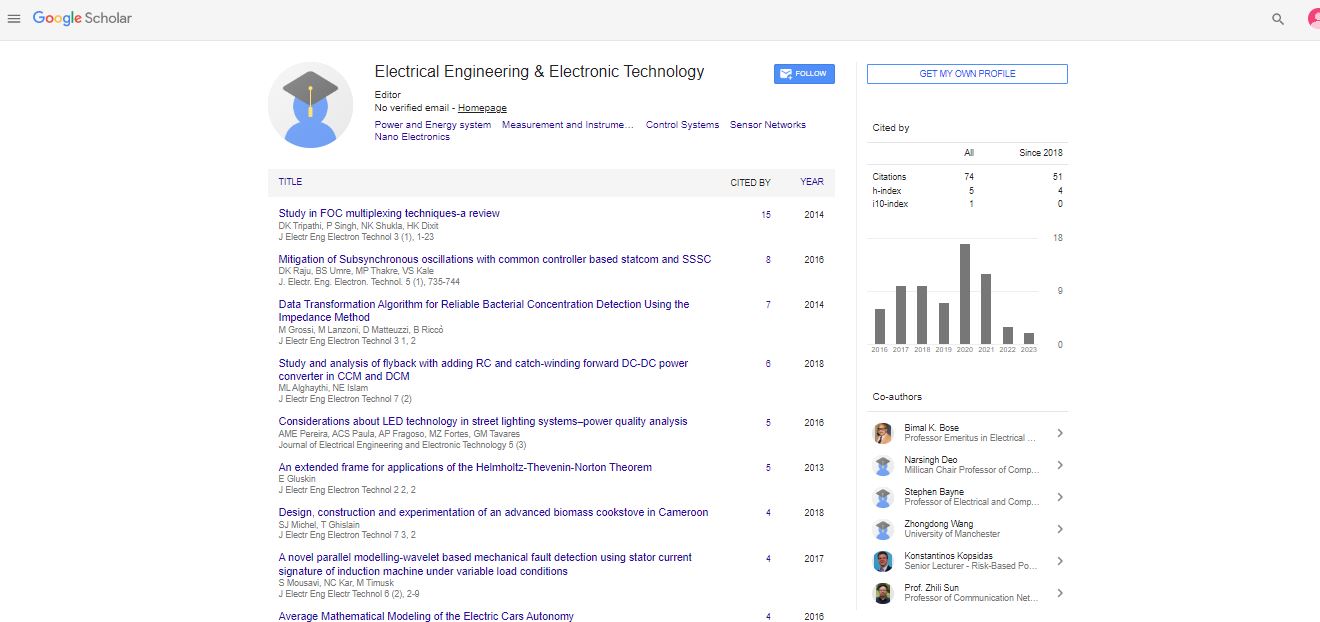Editorial, J Electr Eng Electron Technol Vol: 14 Issue: -2
Blockchain in Energy Systems: Transforming the Future of Energy Management
Dr. Suneeta Devi*
Department of electrical, Jawaharlal Nehru University, India
- *Corresponding Author:
- Dr. Suneeta Devi
Department of electrical, Jawaharlal Nehru University, India
E-mail: dr@suneeta645gmail.com
Received: 01-Mar-2025, Manuscript No. jeeet-25-170135; Editor assigned: 4-Mar-2025, Pre-QC No. jeeet-25-170135 (PQ); Reviewed: 18-Mar-2025, QC No. jeeet-25-170135; Revised: 25-Mar-2025, Manuscript No. jeeet-25-170135 (R); Published: 31-Mar-2025, DOI: 10.4172/2325-9838.10001006
Citation: Suneeta D (2025) Blockchain in Energy Systems: Transforming the Future of Energy Management. J Electr Eng Electron Technol 14: 1006
Introduction
The energy sector is undergoing a dramatic transformation driven by the need for sustainability, efficiency, and decentralization. Traditional energy systems, often centralized and reliant on fossil fuels, are being challenged by renewable energy sources, smart grids, and digital innovations. Among the most promising technologies enabling this transition is blockchain. Known primarily as the backbone of cryptocurrencies like Bitcoin, blockchain technology offers unique features that can revolutionize energy systems by enhancing transparency, security, and peer-to-peer interactions [1].
Discussion
Blockchain is a decentralized digital ledger technology that records transactions in a secure, immutable, and transparent manner. Each transaction is grouped into a block and linked cryptographically to previous blocks, forming a chain. This architecture eliminates the need for central authorities or intermediaries, making it ideal for complex, distributed systems like energy networks [2].
In energy systems, blockchain enables peer-to-peer (P2P) energy trading, where consumers can directly buy and sell excess energy generated from renewable sources such as solar panels or wind turbines. This decentralizes energy markets, empowering prosumers (producers and consumers) to participate actively in energy exchange without relying on traditional utility companies. Blockchainâ??s transparency ensures that transactions are verifiable and tamper-proof, reducing fraud and disputes [3].
Additionally, blockchain enhances the management of distributed energy resources (DERs). With the growing integration of solar panels, electric vehicles, and energy storage systems, balancing supply and demand becomes complex. Blockchain facilitates real-time tracking, automated settlement, and smart contracts that execute predefined rules without human intervention. For example, a smart contract can automatically compensate an electric vehicle owner for feeding stored energy back into the grid during peak demand [4].
Another critical application is improving grid transparency and security. Energy systems face challenges related to data integrity, cybersecurity threats, and inefficient billing processes. Blockchainâ??s decentralized ledger prevents unauthorized data alterations and enhances trust among stakeholders. By providing an auditable trail of energy transactions, blockchain supports regulatory compliance and carbon accounting, aiding efforts to reduce greenhouse gas emissions [5].
However, integrating blockchain into energy systems also presents challenges. The technologyâ??s current energy consumption, particularly in consensus mechanisms like Proof of Work, raises sustainability concerns. Moreover, scalability issues and regulatory uncertainties need to be addressed for widespread adoption. Innovations such as energy-efficient consensus algorithms (Proof of Stake, Byzantine Fault Tolerance) and supportive policy frameworks are essential to overcome these barriers.
Conclusion
Blockchain technology holds significant potential to reshape energy systems by enabling decentralized, transparent, and secure energy transactions. Through peer-to-peer trading, efficient management of distributed resources, and enhanced grid transparency, blockchain contributes to a more resilient and sustainable energy future. While challenges remain, ongoing technological advancements and regulatory developments are paving the way for blockchain to become a cornerstone of modern energy infrastructure. As the world moves towards cleaner and smarter energy solutions, blockchain stands out as a transformative tool to empower consumers, streamline operations, and accelerate the transition to a low-carbon economy.
References
- Hopkins AL (2008) Network pharmacology: the next paradigm in drug discovery. Nature chemical biology 4:682-690.
- Faccenda E, Maxwell S, Szarek JL (2019) The IUPHAR pharmacology education project. Clin Pharmacol Ther 105:1-45.
- Magavern EF, Cremers S (2021) Introduction to clinical pharmacology at large. Br J Clin Pharmacol 87:3026-3027.
- Osswald W (2020) What next, Portuguese Society of Pharmacology? Pharmacological Research 105310-105310.
- Winquist RJ, Mullane K, Williams M (2014) The fall and rise of pharmacologyâ??(Re-) defining the discipline? Biochemical Pharmacology 87:4-24.
Indexed at, Crossref, Google Scholar
Indexed at, Crossref, Google Scholar
Indexed at, Crossref, Google Scholar
Indexed at, Crossref, Google Scholar
 Spanish
Spanish  Chinese
Chinese  Russian
Russian  German
German  French
French  Japanese
Japanese  Portuguese
Portuguese  Hindi
Hindi 
